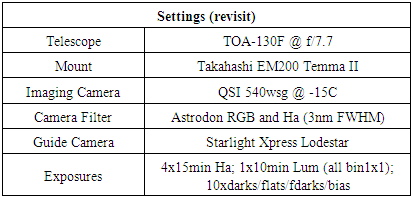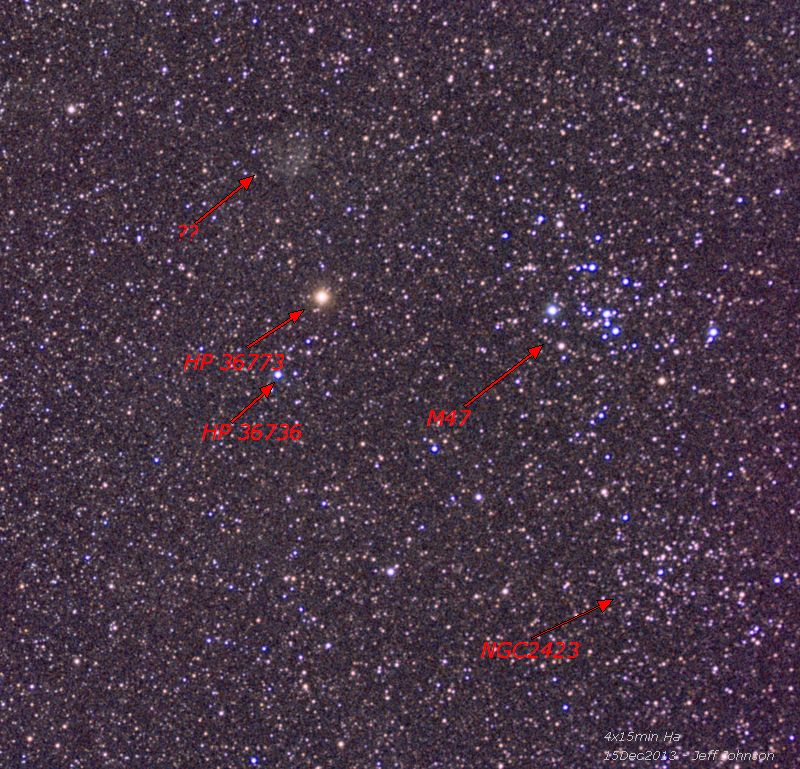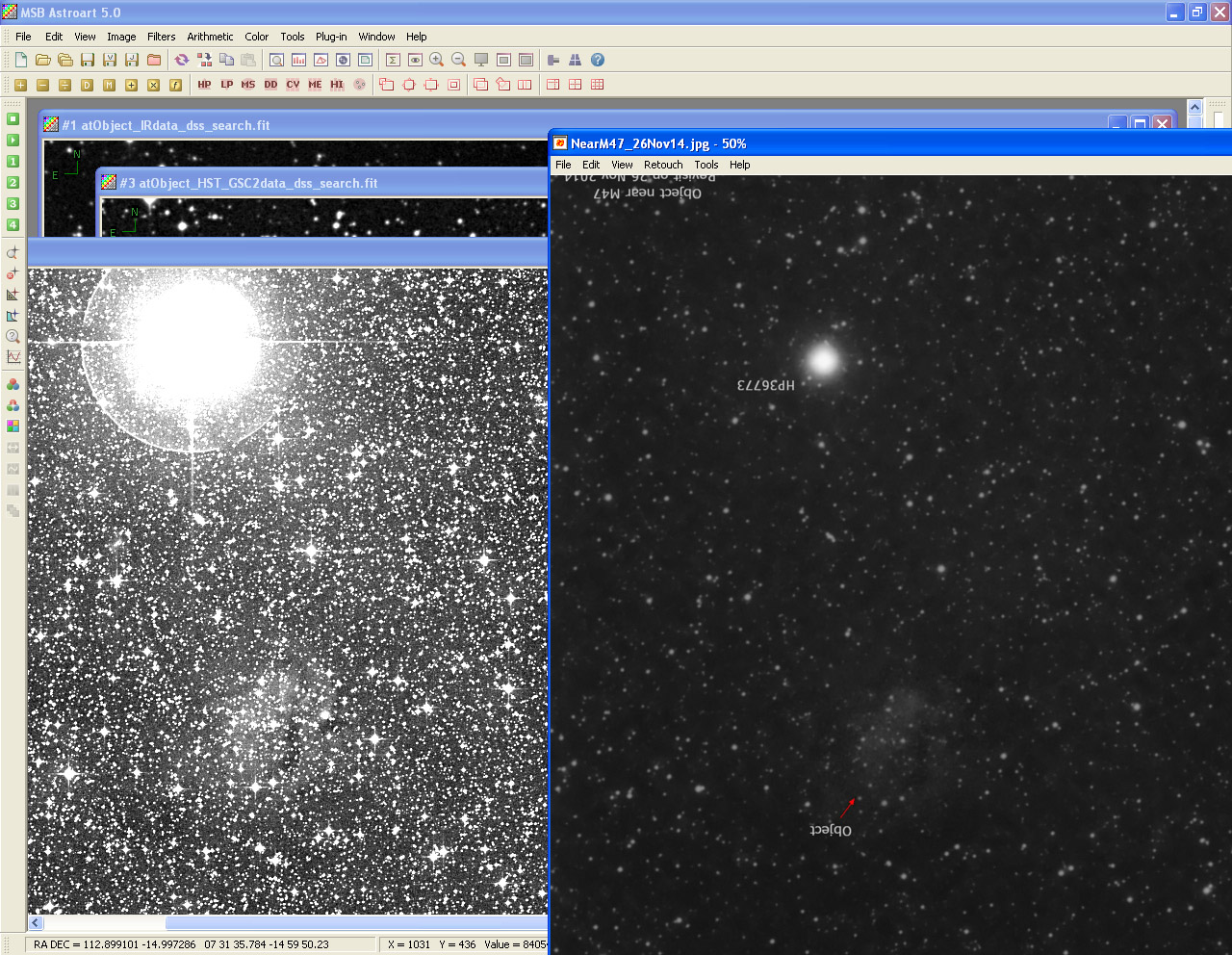-
Paper Information
- Paper Submission
-
Journal Information
- About This Journal
- Editorial Board
- Current Issue
- Archive
- Author Guidelines
- Contact Us
International Journal of Astronomy
p-ISSN: 2169-8848 e-ISSN: 2169-8856
2017; 6(1): 1-5
doi:10.5923/j.astronomy.20170601.01

Emission Nebula Discovery in Puppis
Jeffrey O. Johnson
Astrophotography by Jeff Johnson, Las Cruces, NM, United States
Correspondence to: Jeffrey O. Johnson, Astrophotography by Jeff Johnson, Las Cruces, NM, United States.
| Email: |  |
Copyright © 2017 Scientific & Academic Publishing. All Rights Reserved.
This work is licensed under the Creative Commons Attribution International License (CC BY).
http://creativecommons.org/licenses/by/4.0/

A previously undocumented emission nebula in Puppis has been discovered during an amateur astronomer imaging session. Originally discovered on 15 December 2013 by the author, the nebula has since been independently verified in 2015. Additionally, a professional astronomer leading efforts in cataloguing hydrogen emission nebulae has confirmed that this nebula had not yet been catalogued at the time of discovery. Since the initial discovery, object data have been subsequently collected at a longer focal length, generating a view that shows more structure to the large, but very faint object.
Keywords: Astronomy, Emission nebulae, HII
Cite this paper: Jeffrey O. Johnson, Emission Nebula Discovery in Puppis, International Journal of Astronomy, Vol. 6 No. 1, 2017, pp. 1-5. doi: 10.5923/j.astronomy.20170601.01.
Article Outline
1. Introduction
- This paper describes a discovery of a previously undocumented and uncataloged emission nebula in the Puppis constellation, relatively low in the southern sky from the location from where the data were collected (New Mexcio, USA). Related work to discoveries by amateur astronomers is normally focused on planetary nebulae, such as the relatively recently-discovered “Soapbubble Nebula” in Cygnus, as well as the “Squid” nebula (Ou4) in Cepheus, and published by Acker, et al. [1]. After correspondence with other astronomers (both amateur and professional), the object described in this paper was determined to be of enough significance to document its presence, location, and overall description based on the data collected to date. This paper is the first documented description to that end.
2. Instruments and Methods
- Instrumentation used for the data collection is listed in Table 1, below. All equipment used is privately owned. The equipment is used as a portable set-up, where set-up each night, and take-down the following morning are performed for each imaging session, including those for the discovery and re-visit of the emission nebula object described in this paper.
|
|
|
3. Results
- During a normal imaging session on 15 Dec 2013, an area of interest near M47 appeared to show Milky Way dust zones, commonly referred to integrated flux nebulae, in Google Earth star maps. No catalogs showed any objects here, and the author believed it was just steallar dust. To investigate this apparent area of background dust, an H-alpha (Ha) narrowband filter (3nm bandwidth) was used to determine if there may also be hydrogen emission areas in this same region. Other studies show Ha areas related to planetary nebulae [2], super-nova remnants [4], as well as helping to assess star accretion rates [3]. As the author planned to image two star clusters (M47 and NGC2423), it involved only a slight offset to examine the surrounding area where the dust regions seemed to be located. The FS-60C telescope coupled with the QSI camera (which uses a Kodak KAI-04022 CCD) allowed for a wide field of view (FOV) of the area.Author’s original website documenting original discovery as well as subsequent findings: http://jeffjastro.com/dso/M47_15Dec13.htm.
3.1. Initial Discovery Processing
- Upon initial processing of the Ha channel data the following morning, a slight “hazy area” in one portion of the frame was identified. Several checks determined that this hazy area was not an optical artefact, such as a reflection. Processing of the resultant data to better bring out the data from the region that appeared to be a nebula was then conducted. Using a combination of levels and curves in various software, the first resultant discovery image is shown in Figure 1. Note that the original attempt included color data (Red, Green, and Blue, or RGB) in an attempt to determine color, but this was a very small data set, so the color was not accurate at the time of this imaging session.
3.2. Contact with Professional Astronomers
- Following initial discovery on 15 Dec 2013, fellow amateur astronomers were contacted. One of the contacts (and published by NASA), Ken Crawford, subsequently introduced the author to Sakib Rasool, who then forwarded the discovery image to professional astronomer [2-4] and astronomy Professor Dr. Quentin A. Parker, Australia. Dr. Parker responded to Mr. Rasool that the HII object has not yet been cataloged, and that “It is a HII region by the look of it. Quite large but also quite faint.” (Dr. Quentin Parker, 17 Jun 2014).In addition to the confirmation email to Mr. Rasool, Dr. Parker included image data he obtained from the UKST H-alpha survey, which clearly showed the as yet uncataloged object.
3.3. Follow-up Data
- Following notification by Dr. Parker, the a follow-up data collection session was conducted by the author the following season on 26 November 2014, using a larger aperture (130mm) and longer focal length (1000mm) Takahashi TOA-130F telescope (Table 3).Results of the 4x15min subframes clearly showed the emission nebula object, as shown and identified as “Object” in Figure 2.
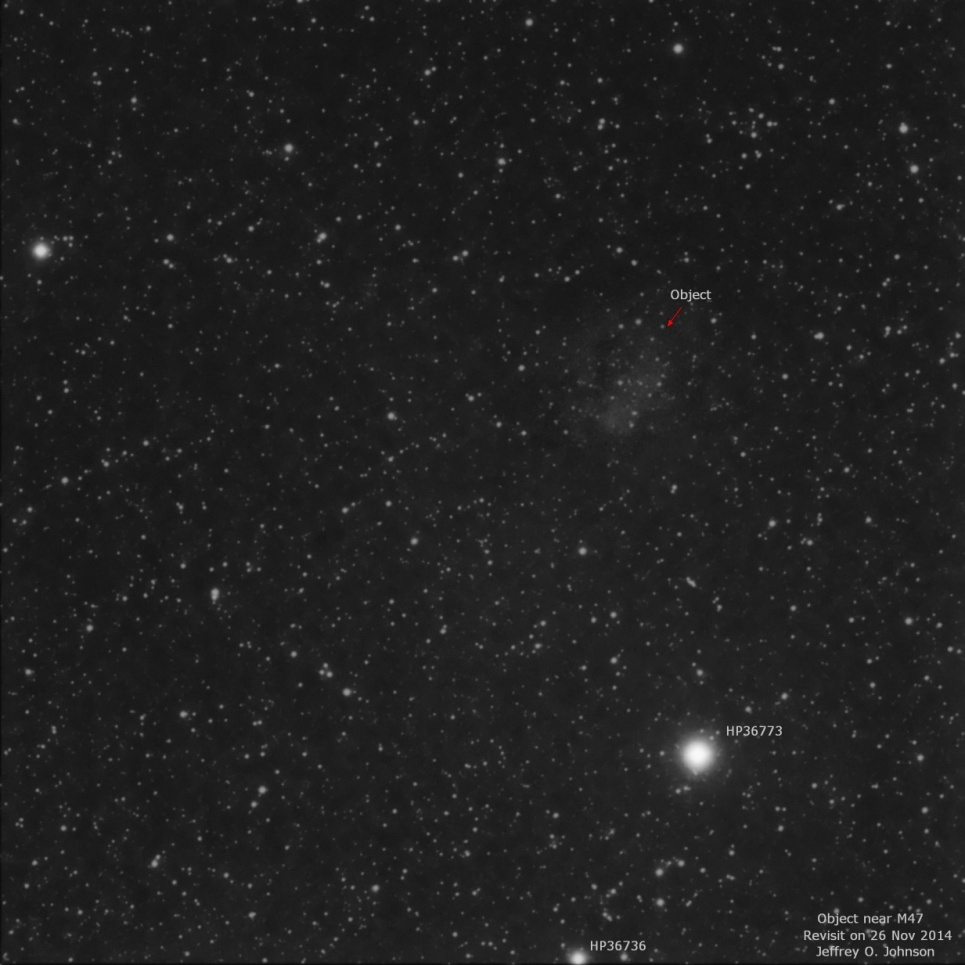 | Figure 2. Follow-up data, 26 Nov 2014 (TOA-130F telescope) |
3.4. Sloan Digital Sky Survey Comparison
- Following processing of the new data set with the larger aperture telescope, the data from the Sloan Digital Sky Survey (SDSS) for the same coordinates of the discovered object were downloaded and rendered using FITS processing software. After orientation adjustments, the object is clearly seen in the SDSS data, as shown in a side by side comparison with the author’s data in Figure 3.
3.5. Independent Verification
- On 20 May 2015 the author received an email from Sakib Rasool. The email stated:”An amateur called Kfir Simon recently took an astroimaging trip to Namibia and I provided a list of imaging targets for him. I also included a special request to take some Ha data for your nebula discovery in Puppis.He has independently verified the existence of this nebula and I have attached his image to this message as well as a FITS header information file I don't understand.I hope to be able to persuade someone to take a closer shot of it, hopefully CHART32 (www.chart32.de).”The result of the independent data collected and processed by accomplished astro-imager Kfir Simon during his astro-imaging trip to Namibia is shown in Figure 4. It should be noted that data and results of another object from the same trip in 2015 by Mr. Simon were published by NASA as an Astronomy Picture of the Day.
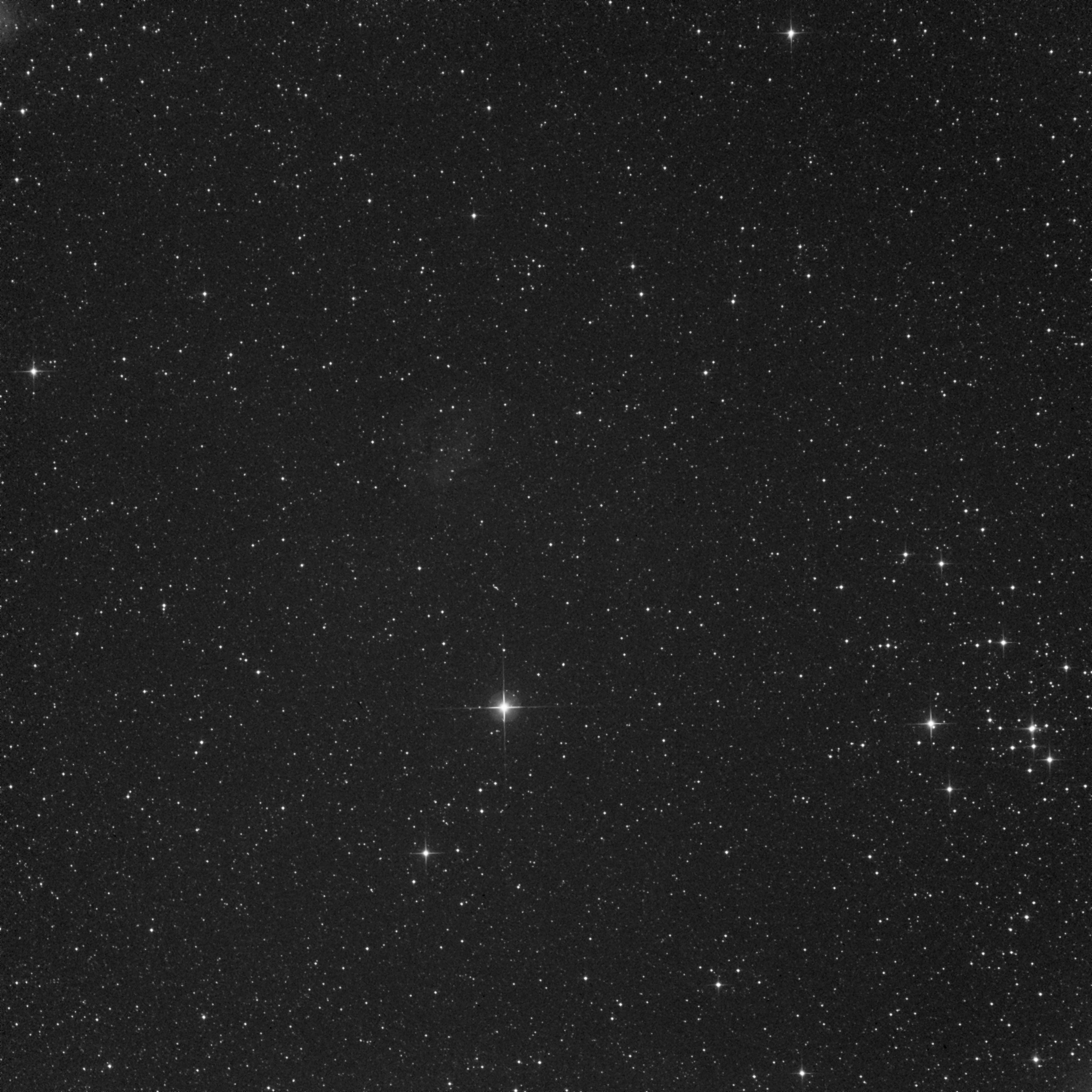 | Figure 4. Independent verification image (Credit: Kfir Simon). Object seen slightly above and left of center |
4. Discussion
- Initial results of the discovered object have ruled out optical artefacts on the data that were collected. Using H-alpha, which helps to identify HII regions (interstellar hydrogen that is ionised), an object was discovered near the coordinates RA 07 33 29.3 DEC -14 52 26.6. Professional astronomers were contacted to determine if the results could be identified as a possible emission nebula region. As described earlier, Dr. Quentin A. Parker identified the region as what seems to be HII. Dr. Parker also provided data from a source which verified the author’s finding – an HII region that had not yet been cataloged.Further follow-up data collection by the author were conducted, both by personally planning and imaging the same region using a larger aperture personal telescope (130mm), as well as further researching scientific databases. All efforts affirmed that this newly discovered region indeed exists.
5. Conclusions
- During an imaging session in December 2013, the author noticed what seemed to be an emission nebula in the area of Puppis. This paper serves as the first official documentation of the discovery of this as yet unpublished emission nebula in Puppis. By estimates of a professional astronomer in Australia, this hydrogen emission region is very faint, but also very large.Further visits for additional data collection of this area are planned by the author as well as contacting a professional observatory to determine if a collaborative effort is possible.
ACKNOWLEDGEMENTS
- The author wishes to acknowledge Ken Crawford, Sakib Rasool, Robert Gendler, and Kfir Simon for their time and advice. Special thanks to Sakib Rasool for contacting professional astronomers regarding this discovery. Special thanks also to Kfir Simon for conducting the independent verification of this object.
 Abstract
Abstract Reference
Reference Full-Text PDF
Full-Text PDF Full-text HTML
Full-text HTML

